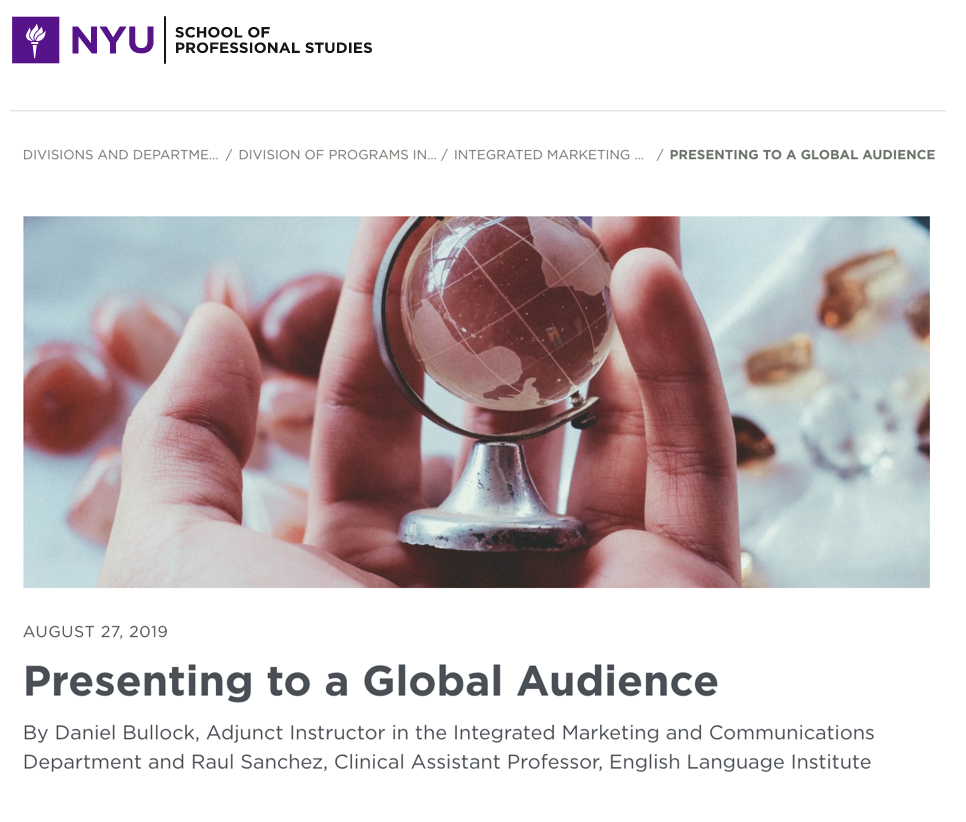In this week’s episode, Dan Bullock and Raul Sanchez, training and communications experts at New York University, speak with Financial Times (“FT Working It”) in London. Both of them are convinced that teaching staff new language and communication skills is the key to a post-pandemic skills refocus - and better global understanding. Could upskilling staff actually help end the Great Resignation?
Creating conversations is how we create relationships, so where would our conversations at work, networking events, or elsewhere be without small talk? Would we have found our best friend, special someone, or valued business partner? Without the light banter between Jeopardy! champion Amy Schneider and Ken Jennings on the quiz show, would we even have known that Schneider powered up with self “pep talks” while listening to Eminem’s “Lose Yourself” before each game?
Think about someone who always seems to command the room during meetings, presentations, or even conversations. What gets their ideas heard and valued? While it could be their smile or eye contact, studies show that our voices greatly impact our impressions.
Our voices matter as much as our words matter. They have the power to awaken the senses and lead others to act, close deals, or land us successful job interviews.
Collaboration has been a corporate buzzword for at least a decade, but even those who have mastered it have had to rethink their approaches at companies that are now largely remote or hybrid.
At Quartz’s recent workshop on how to be a better collaborator in a distributed workforce world, experts in technology and communication offered a range of advice for getting more out of your time with colleagues, whether in meetings or in shared documents.
Artwork by Rod Sánchez
Language is complex and ever-evolving. It comes with slang, idioms, and jargon — all of which are culturally-specific and may be interpreted in various ways by various people. Accurately representing our thoughts, feelings, and ideas through words is a challenge that every one of us, in every industry, faces.
But for those just entering the workforce, this challenge is even greater. As remote “work from anywhere” opportunities grow, more and more people will be interacting on global teams. Forging relationships and clearly communicating with people from diverse backgrounds, located in diverse areas of the world, is going to require…
IGTV AUTHOR TALK: *PART I
IGTV AUTHOR TALK: *PART 2
This is an unusual and potentially very valuable addition to the often generic presentation and networking books that clog up our bookshelves. Sanchez and Bullock want readers to “shift our focus from presenting to our audience to connecting with our audience”. Rather than suggesting different presentation styles for different geographical and cultural audiences — beyond the general recommendation to keep to global English and avoid idioms when speaking to an international cohort — the authors have a loftier purpose in mind. Recommended ReviewBusiness books FT business books: February edition They outline the six types of story…
Body language is just as powerful in the virtual zone as it is in an in-person situation. From the nuance of gestures to vocal variety and eye movements, these telltale indicators help us deliver our messages effectively and provide instructions on how to read another person’s true attitude or feelings. In the work-from-anywhere era of global teams, intentional nonverbal virtual communication is the key to getting our messages across to the other side of the screen.
When we confer over video calls, our bodies must
What prompted you to write this book?
Imagine seeing the earth from a perspective out in space, with clouds of difference melting away to reveal a singular, interconnected world. This vision fueled the creation of the book. By embracing a global mindset, we can expand our communication skills in ways that…
Every speaking situation is an opportunity for change. Whether you are presenting to a small group of co-workers and stakeholders, a conference room of board members, or a larger audience, a universal goal of any presentation is to create a connection between presenter and audience that brings about some kind of change.
But how do you deliver a successful presentation to an international audience and…
Presenting effectively to a global audience requires more than just a strong message. Using visual aids, appealing to multiple communication styles, employing patterns, and using purposeful body language to highlight your points will help you drive your message home and yield the results you want.
Explore each of the four tips listed in this article and how they can improve your presentation and garner more engagement from audiences.
The unrivaled coverage of The Wall Street Journal is available anytime, anywhere on WSJ.com and WSJ mobile and tablet apps. See how NYU Prof. Raúl Sánchez and NYU Prof. Dan Bullock, Professors at New York University School of Professional Studies, use the Journal to keep class discussions moving in the digital world and to teach higher-order thinking skills for managing and innovating abilities as well.
NYU Prof. Dan Bullock and NYU Prof. Raúl Sánchez discuss how in our increasingly interconnected world, the negotiating game is changing. Expert negotiators are no longer seeing negotiating as an opportunity to win, but as an agreement and relationship builder. Read more to learn about what subtle factors matter most when conducting a negotiation in any aspects of life.
NYU Prof. Raúl Sánchez and NYU Prof. Dan Bullock provide four considerations and strategies to keep in mind when communicating through email messages to readers from other cultures.
NYU Prof. Raúl Sánchez and NYU Prof. Dan Bullock use WSJ as a valuable resource for creating real-world simulations. Simulations are transformative tools used to train participants in linking abstract concepts to real-world conditions, with the ultimate aim of developing business communication skill sets across professional disciplines.
Common types of professional training simulations they use include:
Strategic Negotiations
International Business Deals
Conflict Resolution
Risk Management
"Expanding the Universal Connection" Artwork by Rod Sánchez – www.rodsanchez.com
“Spreading United Seeds of Mind” Artwork by Rod Sánchez – www.rodsanchez.com









































